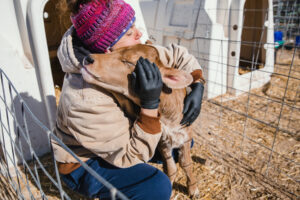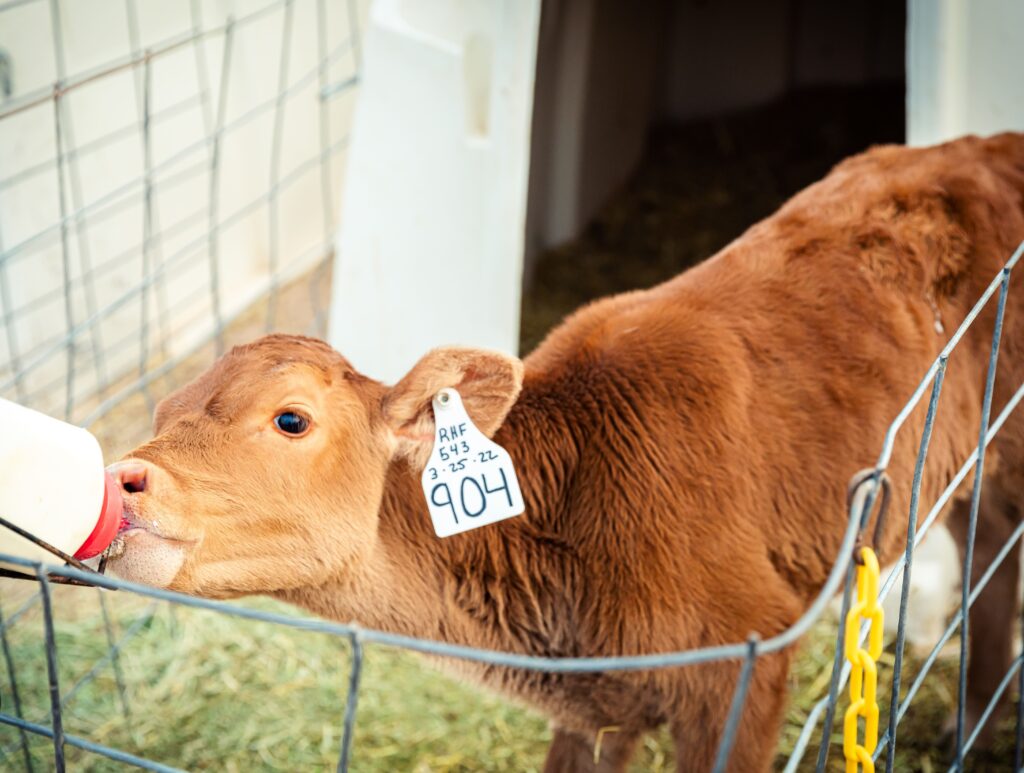One thing we love about our customers is that you care.
You care about the food you’re consuming and its impact on the planet, the people, and the animals who produce it.
So we wanted to address an area we know our customers care about: the well-being of our farm animals, specifically the calves in our dairy herd.
We want to give you a closer look at the first year or so of our dairy cows’ lives so you know exactly how the animals who produce your raw milk are being treated.
Get ready for some serious cow cuteness and real talk about the care of our Redmond calves.
From The Nursery to the Dairy Herd: The First Year(ish)
Breeding and Birth
We aim to breed our dairy cows annually. This can seem like a lot (after all, that would be a TON of birthing for a human!) but it’s normal for wild animals, including bovine species, to give birth every year.
Their bodies are evolutionarily designed to do this, because it increases their chances of producing healthy offspring that will survive to adulthood. So, we’re harnessing the power of nature here.
Our cows always receive the best feed and veterinary care to make their pregnancies and births as smooth and comfortable as possible.
Calf Infancy: The First Months
When calves are born, they spend 12 hours with their mothers before we move the babies to a special “calf nursery,” a warm, snuggly straw bed and a little shelter. These temporary calf nurseries give calves a jumpstart on a healthy life.
Real talk: We actually do this for the safety of the calf, because in nature, infant mortality is high. Raising babies in the wild is a risky business. Calves face a lot of threats in the open, including exposure to the elements, getting stepped on by another cow, or even attacks from predators. For coyotes and mountain lions, a newborn calf is an easy meal! Additionally, the risk of pneumonia is high when temperatures vary (like they tend to in our area).
Yes, our calves might be just fine with their mothers, but we want our cows to be as healthy as possible, and for all our calves to grow up to be big healthy cows. After all, you don’t just leave a human baby on the street. You put them in a crib in a nursery where they’re safe and where you can keep a close eye on them.
Separating the calf also allows us to closely monitor their health. We can see if they’re eating and drinking properly, watch for signs of illness or complications, and adjust their care accordingly. We customize our care regimen to meet each calf’s individual needs.
For three or four days after birth, the calves are bottle-fed milk from their mom so they can get plenty of nourishing colostrum. This is a special kind of milk that all mammals (humans included) produce for the first few days after giving birth, and it plays a huge role in developing the baby’s immune system.
After a colostrum diet, the babies transition to fresh, warm milk we set aside when we do our regular milking.
Calf “Childhood”: 2 to 14 Months
After a few months, calves get to hang out with other calves their age, kind of like a primary school. Cows are herd animals, so once they’re strong enough to roughhouse, we want them to have lots of social interaction. (Mostly from cows, but they also get to hang out with farm cats!)
Around four or five months old, they’re weaned off milk and transitioned to the high-quality diet of fresh grass, organic hay, sprouted barley, and supplements that our adult cows enjoy.
When calves are around a year old, they move to the dry pen with cows who are taking a break from being milked. This helps ease them back into the herd.
At 14 or 15 months, the calves have grown into mature cows. This is when we start to breed them. This is also when they join our milking herd and are reunited with their moms. The milking herd may include their aunties, grandma, sisters, and friends too!
TLC: Totally Loved Calves
 We do everything we can to ensure that our cows enjoy a high quality of life from the very beginning. Our girls receive the best food, veterinary care, and shelter, as well as lots of interaction with other cows and humans who love them.
We do everything we can to ensure that our cows enjoy a high quality of life from the very beginning. Our girls receive the best food, veterinary care, and shelter, as well as lots of interaction with other cows and humans who love them.
Our farmers lovingly attend to our cows and know them as individuals. They to talk them, sing to them, sing to them, and refer to them as “who” and “everyone.” They also name them. If you’ve followed us on Instagram for a while, you might remember Mango!
Our cows live their lives on our farm, in our barns and pastures with their friends and family.
We have three to four generations on our farms, and our cows easily live up to 17 years old (for comparison, most conventional dairy cows live four to five years). They spend their lives surrounded by their moms, daughters, grandmas, aunts, and sisters.
We give them lots of care as babies to help them grow into healthy adults, and this in turn creates quality milk and a sustainable farming practice that will support our animals, the planet, and our customers for generations to come.


